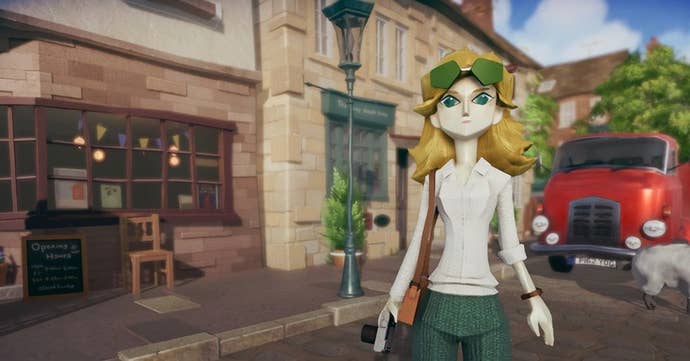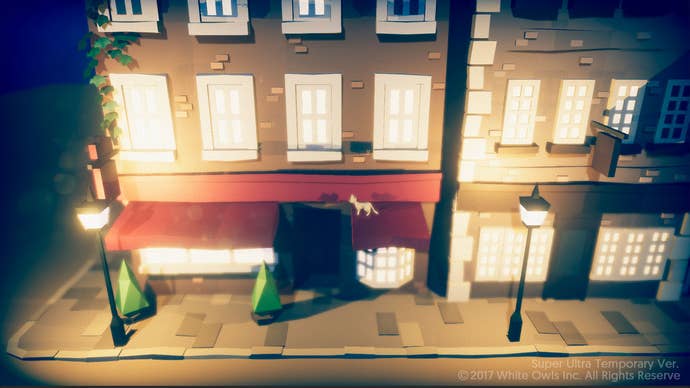With The Good Life, Swery Aspires to Make Life and Games Truly Good
But maybe that's a given in a game where you can ride around on the back of a sheep.
This article first appeared on USgamer, a partner publication of VG247. Some content, such as this article, has been migrated to VG247 for posterity after USgamer's closure - but it has not been edited or further vetted by the VG247 team.
Game designer Hidetaka Suehiro (better known as SWERY65) isn't nearly the maverick auteur one might assume. Although his numeric nickname calls to mind the brash, aggressive posturing of Goichi Suda (aka SUDA51), the two men's personalities couldn't be more different. Swery may not be shy about playing up his quirky side for press and fans, but in a one-to-one chat he comes across as down-to-earth, bordering almost on bashful. His thoughtful nature sits at odds with the high-energy bombast of his most recent project, Dark Dream Don't Die, but it certainly explains the surreal Twin Peaks-inspired tone of his cult breakout title Deadly Premonition. And it absolutely feels in keeping with his upcoming creation, the recently crowdfunded adventure game The Good Life.
The Good Life looks wildly different from D4 or Deadly Premonition, boasting a colorful, cartoon-like visual style. The soft palettes and simplified character designs call to mind the work of Double Fine or maybe a LucasArts adventure game—a deliberate choice, Swery says, to reach a wider audience than his previous work.
"From my experiences beginning with Deadly Premonition onward, I found that women tend to like the story aspects of the game, and they like the drama," he explains. "But if the game looks too cool or too scary or whatever, they don't necessarily want to play it themselves. They'd rather stand by and watch as someone else plays, without actually interacting with the game. So I'm deliberately trying to go through the game and make it a style women will find more approachable. In other words, I want both men and women to be able to enjoy this game at the same time. Maybe for different reasons, but the important thing is they both enjoy it."
While Swery's line of reasoning here is fraught with potential peril—huge portions of the gaming audience bristle at the prospect of developers specifically courting women, while others resent the implication that women need to be "talked down" to—I get the impression his goal with The Good Life is more about simply catching women's attention than about pandering or changing the nature of his game design philosophy. And it's a sensible approach; his past few projects have appeared heavily geared toward core male gamers, yet the actual nature of his creations doesn't especially line up with that audience. Swery tends to prefer offbeat, unconventional games that don't concern themselves overmuch with satisfying post-college dudes who mostly spend their time with, say, Call of Duty multiplayer.
"I haven't really changed the game's design and themes very much from what I've created before," Swery says. "There'll still be grotesque elements and erotic elements. I think those are necessary things for the kinds of games I want to design. But, I've deliberately made the graphics themselves something women might find intriguing and think, 'I want to play this myself.'"

Look beyond the whimsical characters and sedate rural village environments and you'll find a game that fundamentally doesn't stray too far from the template Swery has been working against for the past decade. The Good Life appears to be a free-form game centered heavily on interacting with other characters and performing mundane tasks as a basis for venturing out into more adventuresome tasks. "I want to create a 'life cycle' game," he says. "You take pictures, you turn those pictures into money. You do some side jobs... but that alone's not enough. I also want to create a story game that you can experience on top of the life cycle.
"I want to make a game very much like Deadly Premonition, but I also want it to be an open-ended experience. It's important to me that once you complete the game, that's not the end—I want there to be a lot of extra content. At the same time, I want it to be similar to D4, a sort of multiverse. When we made Deadly Premonition, it was a game where when you got to the ending... it was over. I've always wanted to build a world that you can continue to experience once the story's over. That's something I wanted to do with Deadly Premonition and D4, something I've been thinking about for a long time."
Even if The Good Life builds on ideas Swery has already explored in his previous creations, you can hardly accuse it of being a mere reprise. Beyond its more relaxed visual style, the new game also incorporates a few mechanics that fundamentally change the nature of its action, including the ability to transform into a cat or a dog.
"I know I'm taking on a very large challenge," Swery admits, "but I want to take the metamorphosis mechanic and make it so there are different parts of the world you can explore. Different things you can do as a human that only humans can do; things only dogs can do; things only cats can do. I want there to be lots of different parts to the world you can only explore in different forms.
"The current plan is to make it so that cats, dogs, and humans can each do different things. With a cat you can climb trees and buildings to get places no other form can get to. With the dog you can go for very long distances. As a human, you can interact with the other humans around you and get a sort of world feel that the other forms can't. The full distance of the world hasn't been decided on, but it would be very difficult to walk around the whole thing. You'll be able to catch sheep and ride them around the village."

With its leisurely pace, emphasis on social mechanics, and work-a-day-job systems, The Good Life almost comes across as a work in the Animal Crossing vein. Swery doesn't flinch from the comparison, though, openly acknowledging the inspiration Nintendo's popular slow-life series has had on his work.
"I was sort of aiming for an Animal Crossing kind of thing," he says, "but I don't really want people to feel like it's precisely that kind of game. I want people to be able to live an adult slow life. You can pick an apple, but you don't have to. It's your freedom to do whatever you want."
Particularly relevant to this comparison is Swery's plan to make The Good Life a single-player game that nevertheless contains a meaty social element. As he explains it, "There'll be online components to the game, but it's still going to be a single-player experience. You'll be able to go to your friends' villages, and depending on player actions the NPC activity will change, or the environment will change. So the cool thing will be to go to your friends' village and see how it's completely different from yours."
To hear Swery tell it, this social component cuts to the heart of his ambitions for the game. By making The Good Life more inclusive and placing players in touch with one another through the game world, he hopes to offer up something unique in gaming—something meaningful.
"I believe that games are experiences, and the times you play and play with your friends are very precious," he says. "I hope that people who play this game and grow up to be adults can take this game with them and share it with their kids and pass that experience onto them.
"I'm doing my best to avoid creating a game full of the experiences you have with other games. I want to create new experiences. Games where you play as an alien and fight them off with guns... I don't need to create that kind of game."





